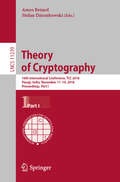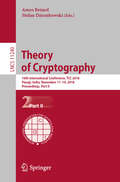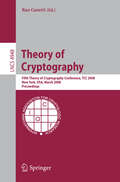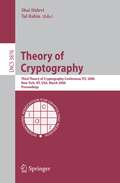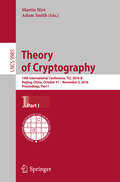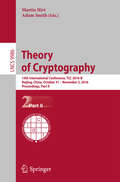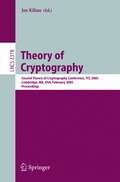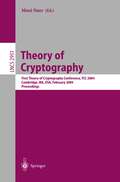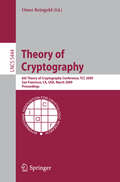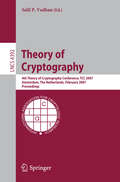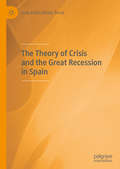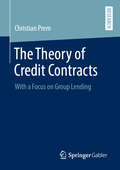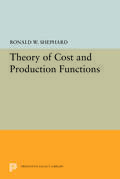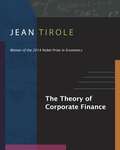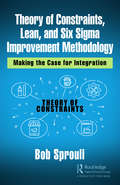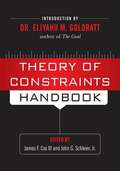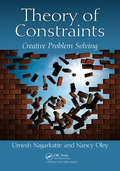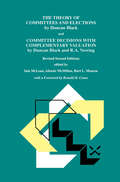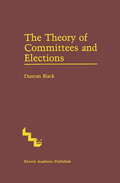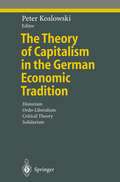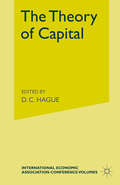- Table View
- List View
Theory of Cryptography: 16th International Conference, Tcc 2018, Panaji, India, November 11-14, 2018, Proceedings, Part Ii (Lecture Notes in Computer Science #11240)
by Amos Beimel Stefan DziembowskiThe two-volume set of LNCS 11239 and LNCS 11240 constitutes the revised proceedings of the 16th International Conference on Theory of Cryptography, TCC 2018, held in Panaji, India, in November 2018.The total of 50 revised full papers presented in the proceedings were carefully reviewed and selected from 168 submissions. The Theory of Cryptography Conference deals with the paradigms, approaches, and techniques used to conceptualize natural cryptographic problems and provide algorithmic solutions to them and much more.
Theory of Cryptography: 16th International Conference, Tcc 2018, Panaji, India, November 11-14, 2018, Proceedings, Part Ii (Lecture Notes in Computer Science #11240)
by Amos Beimel Stefan DziembowskiThe two-volume set of LNCS 11239 and LNCS 11240 constitutes the revised proceedings of the 16th International Conference on Theory of Cryptography, TCC 2018, held in Panaji, India, in November 2018.The total of 50 revised full papers presented in the proceedings were carefully reviewed and selected from 168 submissions. The Theory of Cryptography Conference deals with the paradigms, approaches, and techniques used to conceptualize natural cryptographic problems and provide algorithmic solutions to them and much more.
Theory of Cryptography: Fifth Theory of Cryptography Conference, TCC 2008, New York, USA, March 19-21, 2008, Proceedings (Lecture Notes in Computer Science #4948)
by Ran CanettiTheory of Cryptography: Third Theory of Cryptography Conference, TCC 2006, New York, NY, USA, March 4-7, 2006, Proceedings (Lecture Notes in Computer Science #3876)
by Shai Halevi Tal RabinThis book constitutes the refereed proceedings of the Third Theory of Cryptography Conference, TCC 2006, held in March 2006. The 31 revised full papers presented were carefully reviewed and selected from 91 submissions. The papers are organized in topical sections on zero-knowledge, primitives, assumptions and models, the bounded-retrieval model, privacy, secret sharing and multi-party computation, universally-composible security, one-way functions and friends, and pseudo-random functions and encryption.
Theory of Cryptography: 14th International Conference, TCC 2016-B, Beijing, China, October 31-November 3, 2016, Proceedings, Part I (Lecture Notes in Computer Science #9985)
by Martin Hirt Adam SmithThe two-volume set LNCS 9985 and LNCS 9986 constitutes the refereed proceedings of the 14th International Conference on Theory of Cryptography, TCC 2016-B, held in Beijing, China, in November 2016.The total of 45 revised full papers presented in the proceedings were carefully reviewed and selected from 113 submissions. The papers were organized in topical sections named: TCC test-of-time award; foundations; unconditional security; foundations of multi-party protocols; round complexity and efficiency of multi-party computation; differential privacy; delegation and IP; public-key encryption; obfuscation and multilinear maps; attribute-based encryption; functional encryption; secret sharing; new models.
Theory of Cryptography: 14th International Conference, TCC 2016-B, Beijing, China, October 31-November 3, 2016, Proceedings, Part II (Lecture Notes in Computer Science #9986)
by Martin Hirt Adam SmithThe two-volume set LNCS 9985 and LNCS 9986 constitutes the refereed proceedings of the 14th International Conference on Theory of Cryptography, TCC 2016-B, held in Beijing, China, in November 2016.The total of 45 revised full papers presented in the proceedings were carefully reviewed and selected from 113 submissions. The papers were organized in topical sections named: TCC test-of-time award; foundations; unconditional security; foundations of multi-party protocols; round complexity and efficiency of multi-party computation; differential privacy; delegation and IP; public-key encryption; obfuscation and multilinear maps; attribute-based encryption; functional encryption; secret sharing; new models.
Theory of Cryptography: Second Theory of Cryptography Conference, TCC 2005, Cambridge, MA, USA, February 10-12. 2005, Proceedings (Lecture Notes in Computer Science #3378)
by Joe KilianTCC 2005, the 2nd Annual Theory of Cryptography Conference, was held in Cambridge,Massachusetts,onFebruary10–12,2005.Theconferencereceived84 submissions,ofwhichtheprogramcommitteeselected32forpresentation.These proceedings contain the revised versions of the submissions that were presented at the conference. These revisions have not been checked for correctness, and the authors bear full responsibility for the contents of their papers. The conference program also included a panel discussion on the future of theoretical cryptography and its relationship to the real world (whatever that is). It also included the traditional “rump session,” featuring short, informal talks on late-breaking research news. Much as hatters of old faced mercury-induced neurological damage as an occupational hazard, computer scientists will on rare occasion be a?icted with egocentrism, probably due to prolonged CRT exposure. Thus, you must view withpityandnotcontemptmyunalloyedelationathavingmynameonthefront cover of this LNCS volume, and my deep-seated conviction that I fully deserve the fame and riches that will surely come of it. However, having in recent years switched over to an LCD monitor, I would like to acknowledge some of the many who contributed to this conference. First thanks are due to the many researchers from all over the world who submitted their work to this conference. Lacking shrimp and chocolate-covered strawberries, TCC has to work hard to be a good conference. As a community, I think we have.
Theory of Cryptography: First Theory of Cryptography Conference, TCC 2004, Cambridge, MA, USA, February 19-21, 2004, Proceedings (Lecture Notes in Computer Science #2951)
by Moni NaorTheory of Cryptography: Sixth Theory of Cryptography Conference, TCC 2009, San Francisco, CA, USA, March 15-17, 2009, Proceedings (Lecture Notes in Computer Science #5444)
by Omer ReingoldTCC 2009, the 6th Theory of Cryptography Conference, was held in San Fr- cisco, CA, USA, March 15–17, 2009. TCC 2009 was sponsored by the Inter- tional Association for Cryptologic Research (IACR) and was organized in - operation with the Applied Crypto Group at Stanford University. The General Chair of the conference was Dan Boneh. The conference received 109 submissions, of which the Program Comm- tee selected 33 for presentation at the conference. These proceedings consist of revised versions of those 33 papers. The revisions were not reviewed, and the authors bear full responsibility for the contents of their papers. The conference program also included two invited talks: “The Di?erential Privacy Frontier,” given by Cynthia Dwork and “Some Recent Progress in Lattice-Based Crypt- raphy,” given by Chris Peikert. I thank the Steering Committee of TCC for entrusting me with the resp- sibility for the TCC 2009 program. I thank the authors of submitted papers for their contributions. The general impression of the Program Committee is that the submissions were of very high quality, and there were many more papers we wanted to accept than we could. The review process was therefore very - warding but the selection was very delicate and challenging. I am grateful for the dedication, thoroughness,and expertise ofthe ProgramCommittee. Obse- ing the way the members of the committee operated makes me as con?dent as possible of the outcome of our selection process.
Theory of Cryptography: 4th Theory of Cryptography Conference, TCC 2007, Amsterdam, The Netherlands, February 21-24, 2007, Proceedings (Lecture Notes in Computer Science #4392)
by Salil P. VadhanThis book constitutes the refereed proceedings of the 4th Theory of Cryptography Conference, TCC 2007, held in Amsterdam, The Netherlands in February 2007. The 31 revised full papers cover encryption, universally composable security, arguments and zero knowledge, notions of security, obfuscation, secret sharing and multiparty computation, signatures and watermarking, private approximation and black-box reductions, and key establishment.
The Theory of Crisis and the Great Recession in Spain
by Juan Pablo Mateo ToméThis book has a dual purpose. Firstly, it analyses the concept of economic crises within economic theory, showing the various theoretical foundations and controversies amongst different schools of economic thought. Secondly, it presents an empirical analysis of the Great Recession in Spain, addressing both the growth period from 1995 to 2007-08 and the subsequent depression until 2013-14.Using a political economy approach, the aim of this book is not to explain the root causes of the 2007-08 crisis but to demonstrate the way in which the tendency towards a crisis manifests itself in a given economy in a historical context. In other words, this book focuses upon the reasons why an issue (such as the crisis of profitability) adopts a certain form, or how it is shaped ─ for example, the process of capital accumulation being led by a real estate bubble. Consequently, the two divisions in this book are linked by the role of the Spanish economy in European capitalism.This theoretical and empirical heterodox approach will be of interest to students and scholars in political economy, and those with an interest in the Eurozone.
The Theory of Credit Contracts: With a Focus on Group Lending
by Christian PremIn this book Christian Prem features new innovations on several levels. On a conceptual level he presents a complete restructuring and modularisation of the field of lending theory. On a formal level he bestows great care on providing precise definitions and promotes notational standardisation. On a technical level the development of an algorithm to solve repayment games automatically is thoroughly documented. Eventually, new theoretic results on the performance of various credit schemes are established, the quality of existing lending schemes is scrutinised and new more efficient mechanisms are presented. The content therefore inspires theorists as well as it provides well-grounded advice to practitioners in the lending industry. Altogether this thesis is a major step towards improving the quality and applicability of lending theory.
Theory of Cost and Production Functions
by Ronald William ShepherdA sequel to his frequently cited Cost and Production Functions (1953), this book offers a unified, comprehensive treatment of these functions which underlie the economic theory of production.The approach is axiomatic for a definition of technology, by mappings of input vectors into subsets of output vectors that represent the unconstrained technical possibilities of production. To provide a completely general means of characterizing a technology, an alternative to the production function, called the Distance Function, is introduced.The duality between cost function and production function is developed by introducing a cost correspondence, showing that these two functions are given in terms of each other by dual minimum problems.The special class of production structures called Homothetic is given more general definition and extended to technologies with multiple outputs.Originally published in 1971.The Princeton Legacy Library uses the latest print-on-demand technology to again make available previously out-of-print books from the distinguished backlist of Princeton University Press. These editions preserve the original texts of these important books while presenting them in durable paperback and hardcover editions. The goal of the Princeton Legacy Library is to vastly increase access to the rich scholarly heritage found in the thousands of books published by Princeton University Press since its founding in 1905.
Theory of Cost and Production Functions (Princeton Studies In Mathematical Economics Ser. #2951)
by Ronald William ShepherdA sequel to his frequently cited Cost and Production Functions (1953), this book offers a unified, comprehensive treatment of these functions which underlie the economic theory of production.The approach is axiomatic for a definition of technology, by mappings of input vectors into subsets of output vectors that represent the unconstrained technical possibilities of production. To provide a completely general means of characterizing a technology, an alternative to the production function, called the Distance Function, is introduced.The duality between cost function and production function is developed by introducing a cost correspondence, showing that these two functions are given in terms of each other by dual minimum problems.The special class of production structures called Homothetic is given more general definition and extended to technologies with multiple outputs.Originally published in 1971.The Princeton Legacy Library uses the latest print-on-demand technology to again make available previously out-of-print books from the distinguished backlist of Princeton University Press. These editions preserve the original texts of these important books while presenting them in durable paperback and hardcover editions. The goal of the Princeton Legacy Library is to vastly increase access to the rich scholarly heritage found in the thousands of books published by Princeton University Press since its founding in 1905.
The Theory of Corporate Finance
by Jean TiroleThe past twenty years have seen great theoretical and empirical advances in the field of corporate finance. Whereas once the subject addressed mainly the financing of corporations--equity, debt, and valuation--today it also embraces crucial issues of governance, liquidity, risk management, relationships between banks and corporations, and the macroeconomic impact of corporations. However, this progress has left in its wake a jumbled array of concepts and models that students are often hard put to make sense of. Here, one of the world's leading economists offers a lucid, unified, and comprehensive introduction to modern corporate finance theory. Jean Tirole builds his landmark book around a single model, using an incentive or contract theory approach. Filling a major gap in the field, The Theory of Corporate Finance is an indispensable resource for graduate and advanced undergraduate students as well as researchers of corporate finance, industrial organization, political economy, development, and macroeconomics. Tirole conveys the organizing principles that structure the analysis of today's key management and public policy issues, such as the reform of corporate governance and auditing; the role of private equity, financial markets, and takeovers; the efficient determination of leverage, dividends, liquidity, and risk management; and the design of managerial incentive packages. He weaves empirical studies into the book's theoretical analysis. And he places the corporation in its broader environment, both microeconomic and macroeconomic, and examines the two-way interaction between the corporate environment and institutions. Setting a new milestone in the field, The Theory of Corporate Finance will be the authoritative text for years to come.
The Theory of Corporate Finance
by Jean TiroleThe past twenty years have seen great theoretical and empirical advances in the field of corporate finance. Whereas once the subject addressed mainly the financing of corporations--equity, debt, and valuation--today it also embraces crucial issues of governance, liquidity, risk management, relationships between banks and corporations, and the macroeconomic impact of corporations. However, this progress has left in its wake a jumbled array of concepts and models that students are often hard put to make sense of. Here, one of the world's leading economists offers a lucid, unified, and comprehensive introduction to modern corporate finance theory. Jean Tirole builds his landmark book around a single model, using an incentive or contract theory approach. Filling a major gap in the field, The Theory of Corporate Finance is an indispensable resource for graduate and advanced undergraduate students as well as researchers of corporate finance, industrial organization, political economy, development, and macroeconomics. Tirole conveys the organizing principles that structure the analysis of today's key management and public policy issues, such as the reform of corporate governance and auditing; the role of private equity, financial markets, and takeovers; the efficient determination of leverage, dividends, liquidity, and risk management; and the design of managerial incentive packages. He weaves empirical studies into the book's theoretical analysis. And he places the corporation in its broader environment, both microeconomic and macroeconomic, and examines the two-way interaction between the corporate environment and institutions. Setting a new milestone in the field, The Theory of Corporate Finance will be the authoritative text for years to come.
Theory of Constraints, Lean, and Six Sigma Improvement Methodology: Making the Case for Integration
by Bob SproullMany leaders and managers have led improvement initiatives in a variety of different industry sectors. Most believe that when they begin these efforts, they already have the tools they need in their improvement "backpack." Using these tools, they make substantial improvements to processes in a wide array of industry segments. As time passes, however, most realize that there is a missing link in their arsenal of tools for improvement. The author of this book faced this same predicament and he discovered what the missing link was in his improvement tool kit: Theory of Constraints (TOC). Once he learned the details of TOC, his ability to make major improvements jettisoned upward to levels he had not seen before. TOC is the common denominator in all the case studies presented in this book. This book opens with a chapter on what Theory of Constraints is and why it works so well in improvement efforts. The second and third chapters cover the important points related to Lean Manufacturing and Six Sigma as well as key points related to variability. Chapter 4 demonstrates how to effectively combine these three components to achieve maximum improvement and the corresponding enhancement to your company’s profitability. The remainder of this book is composed of true case studies from different industry segments, using this integrated improvement methodology. Essentially, this book lays the foundation for what most practitioners are just beginning to understand—this integrated improvement methodology is superior to the three components used in isolation from each other. This book presents a step-by-step method of how to combine the Theory of Constraints, Lean, and Six Sigma, and then demonstrates its effectiveness in a very diverse array of industries.
Theory of Constraints, Lean, and Six Sigma Improvement Methodology: Making the Case for Integration
by Bob SproullMany leaders and managers have led improvement initiatives in a variety of different industry sectors. Most believe that when they begin these efforts, they already have the tools they need in their improvement "backpack." Using these tools, they make substantial improvements to processes in a wide array of industry segments. As time passes, however, most realize that there is a missing link in their arsenal of tools for improvement. The author of this book faced this same predicament and he discovered what the missing link was in his improvement tool kit: Theory of Constraints (TOC). Once he learned the details of TOC, his ability to make major improvements jettisoned upward to levels he had not seen before. TOC is the common denominator in all the case studies presented in this book. This book opens with a chapter on what Theory of Constraints is and why it works so well in improvement efforts. The second and third chapters cover the important points related to Lean Manufacturing and Six Sigma as well as key points related to variability. Chapter 4 demonstrates how to effectively combine these three components to achieve maximum improvement and the corresponding enhancement to your company’s profitability. The remainder of this book is composed of true case studies from different industry segments, using this integrated improvement methodology. Essentially, this book lays the foundation for what most practitioners are just beginning to understand—this integrated improvement methodology is superior to the three components used in isolation from each other. This book presents a step-by-step method of how to combine the Theory of Constraints, Lean, and Six Sigma, and then demonstrates its effectiveness in a very diverse array of industries.
Theory Of Constraints Handbook (PDF)
by James F. Cox John G. SchleierIn this authoritative volume, the world's top Theory of Constraints (TOC) experts reveal how to implement the ground-breaking management and improvement methodology developed by Dr. Eliyahu M. Goldratt. Theory of Constraints Handbook offers an in-depth examination of this revolutionary concept of bringing about global organization performance improvement by focusing on a few leverage points of the system. Clear explanations supplemented by examples and case studies define how the theory works, why it works, what issues are resolved, and what benefits accrue, and demonstrate how TOC can be applied to different industries and situations.
Theory of Constraints: Creative Problem Solving
by Umesh P. Nagarkatte Nancy OleyThis book was written to assist professionals and students to become proactive in their own education, improve thinking, resolve personal and interpersonal conflicts, improve pedagogy, manage departmental affairs and guide administrative decisions. The text captures the practical experience of the authors with and formal training in TOC to address many of the issues facing today’s education stakeholders. The text is designed to teach methods for 1) "win-win" conflict resolution, 2) decision-making, 3) problem solving, and 4) analysis of systems using TOC’s powerful logic-based graphical Thinking Process tools. A creative thinker can identify, plan and achieve his or her goals just knowing the Thinking Process Tools.
Theory of Constraints: Creative Problem Solving
by Umesh P. Nagarkatte Nancy OleyThis book was written to assist professionals and students to become proactive in their own education, improve thinking, resolve personal and interpersonal conflicts, improve pedagogy, manage departmental affairs and guide administrative decisions. The text captures the practical experience of the authors with and formal training in TOC to address many of the issues facing today’s education stakeholders. The text is designed to teach methods for 1) "win-win" conflict resolution, 2) decision-making, 3) problem solving, and 4) analysis of systems using TOC’s powerful logic-based graphical Thinking Process tools. A creative thinker can identify, plan and achieve his or her goals just knowing the Thinking Process Tools.
The Theory of Committees and Elections by Duncan Black and Committee Decisions with Complementary Valuation by Duncan Black and R.A. Newing
by Iain McLean Alistair McMillan Burt L. MonroeR. H. Coase Duncan Black was a close and dear friend. A man of great simplicity, un worldly, modest, diffident, with no pretensions, he was devoted to scholarship. In his single-minded search for the truth, he is an example to us all. Black's first degree at the University of Glasgow was in mathematics and physics. Mathematics as taught at Glasgow seems to have been designed for engineers and did not excite him and he switched to economics, which he found more congenial. But it was not in a lecture in economics but in one on politics that he found his star. One lecturer, A. K. White, discussed the possibility of constructing a pure science of politics. This question caught his imagination, perhaps because of his earlier training in physics, and it came to absorb his thoughts for the rest of his life. But almost certainly nothing would have come of it were it not for his appointment to the newly formed Dundee School of Economics where the rest of the. teaching staff came from the London School of Economics. At Glasgow, economics, as in the time of Adam Smith, was linked with moral philosophy. At Dundee, Black was introduced to the analytical x The Theory o/Committees and Elections approach dominant at the London School of Economics. This gave him the approach he used in his attempt to construct a pure science of politics.
The Theory of Committees and Elections
by Duncan BlackTHIS book or some related work has occupied me spasmodically over rather a long period, in fact ever since I listened to the class lectures of Professor A. K. White on the possibility of forming a pure science of Politics. Mter an earlier version of Part I had failed to obtain publication in 1947, some chapters appeared as articles, and I am obliged to the editors of the journals mentioned below for permission to reprint this material, sometimes in a modified form. When I first attempted publication I was unacquainted with the earlier history of the theory, and, indeed, did not even know that it had a history; and the later additions to the book have largely been by way of writing the present Part II. This historical section does not include the important recent work, Social Ohoice and Individual Values (1951), of Professor Kenneth J. Arrow; but it does include all the mathematical work on committees and elections appearing before the middle of this century which has come to my notice, although the last item in it is dated 1907. No doubt there is much important material which I have failed to see. The theorizing of the book grew out of a reading of the English political philosophers and of the Italian writers on Public Finance. At a very early stage I was helped to find the general lines of development by discussion with my colleague Professor Ronald H.
The Theory of Capitalism in the German Economic Tradition: Historism, Ordo-Liberalism, Critical Theory, Solidarism (Ethical Economy)
by Peter KoslowskiThe theory of capitalism and of the economic order is the central topic of the German economic tradition in the 20th century. Capitalism has not only been the topic for Marxist economics and for the Frankfurt School but also for the Historical School and for the postmarxist theory of capitalism in Ordo- and Neo-Liberalism as well as in Solidarism. The question of the foundations of the economic order of the market economy and of capitalism as well as the problem whether a third path between capitalism and social ism is possible occupied this tradition from the Historical School to Ordo Liberalism and the theory of the social market economy. The theory of capitalism and of the social market economy as well as the critique and reform developed in this theoretical tradition is important for the theory of economic systems as well as for today's problems of the eco nomic order. Its relevance for the present world economy is visible in the discussions whether there exist different models of capitalism and whether they can be described as the Anglo-American and as the Rhenish model of capitalism influenced by the thought of the German economic tradition. Michel Albert, the author of this classification, gave the key-word in his book Capitalism against Capitalism. The papers of this book can help to clarify this debate by giving a first hand introduction to some of the main economic thinkers of capitalism.
